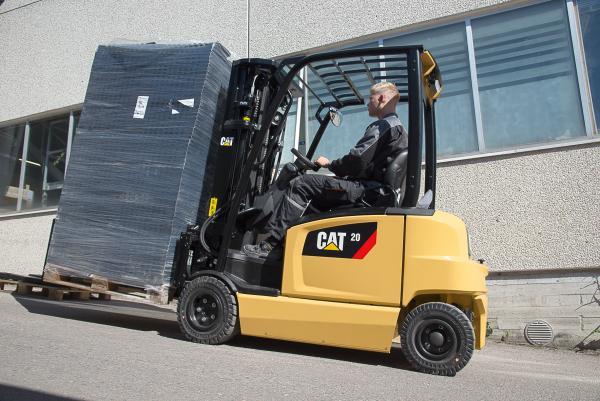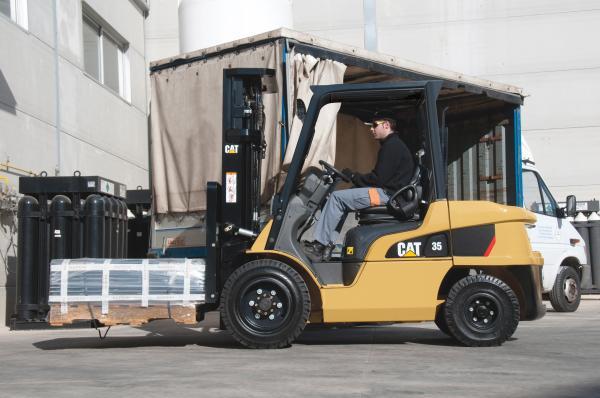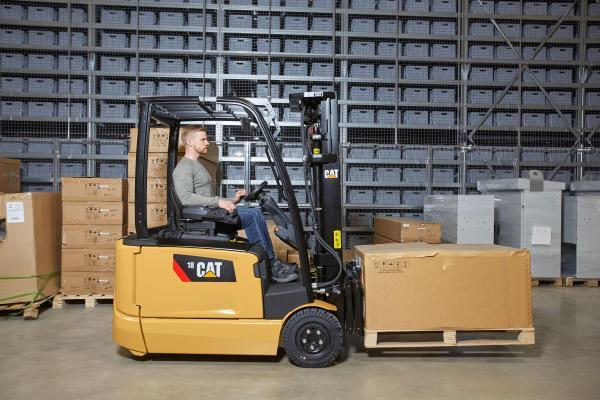Moving goods around your warehouse or depot and storing them in a well-organised way can be a major challenge. But abiding by correct forklift safety procedures will ensure that when loading and unloading heavy items, everything runs smoothly and efficiently and without causing any harm or damage.
If operators fail to abide by the correct procedures, it could lead to queuing, inefficiency, increased costs and injury to operators and others, as well as damage to goods and equipment. Having trained staff that follow the right forklift safety procedures is therefore essential to your materials handling operations.
At Cat® Lift Trucks, not only do we take safety into account when designing our materials handling equipment, but also consider how the people operating them need to perform their tasks. Below are our top tips for loading and unloading your forklift trucks safely.
Before loading your forklift truck:
- Keep in mind that forklifts are for carrying loads and nothing else.
- Be aware of your surroundings and observe all signs, especially those for maximum permitted floor loadings and clearance heights, and check for any overhead objects before lifting or stacking loads.
- The load should be carefully checked to ensure it’s suitable, undamaged and stable for the forklift – avoid lifting anything that isn’t safe or firm enough to do so.
- Make sure the load is carefully and correctly positioned on the pallet or skid - evenly distributed, safe and secure to avoid it collapsing whilst on the forklift.
- Only use pallets and skids that can withstand the weight of the load and check that there are no damaged, deformed or decaying pallets holding the loads.
- Ensure the ground is flat - never load or unload your forklift on a ramp or uneven surface and check the floor can support the combined weight of the forklift and the load.
- If loading or unloading from a lorry, check that the brakes of the vehicle are set up to stop it moving or that chocks are in place. Our EP14-20A(C)N(T) 48V truck range comes with Presence Detection System+ which includes automatic parking brake, hill hold and – if operator is not seated – prevention of travel and hydraulic movement, to ensure safety in loading situations.
- Check that the height of the vehicle's entrance door clears the forklift height by at least 5 cm (2 in.).
How to load your forklift:
- While loading, ensure the goods are evenly distributed, correctly stacked and positioned across both forks to avoid any collapsing and damage to the contents. Do not lift a load with one fork.
- Ensure the load is fully secure before moving the forklift. Use securing measures such as ropes or bindings if needed.
- Never overload a forklift truck as it’s an accident waiting to happen. Know the capacity of your forklift and any attachments being used and never exceed this capacity. An overloaded vehicle can cause the rear tyres to be raised off the ground and may cause the forklift to tip over.
- Do not use the tip of the forks as a lever to raise a heavy load or push a load with the tip of the forks.
- It is important to ensure that the goods are tilted back with the forks sitting low whilst transporting in order to increase truck stability. Keep the centre of gravity of the load as low to the ground and as close to the front wheels as possible: Carry the load at the lowest position possible, 4 - 6 inches from the ground. Tilt the mast back and position the heaviest part of the load against the carriage.
Unloading your forklift:
- Inspect the load before unloading to make sure the goods have not shifted during transit and are not likely to move or fall when any restraints are removed. If the load has moved in anyway, consider how it can be unloaded safely.
- The area where the unloading is to take place must be suitable for this to be done safely. Check for hazards, such as obstructions in the unloading area, firmness and support of ground or any pedestrians before unloading.
- Ensure the brakes are set and the forklift that you’re unloading isn’t going to move suddenly during the procedure. We’ve specifically designed our EP14-20A(C)N(T) 48V truck range with a Presence Detection System+ which includes automatic parking brake, hill hold and – if operator is not seated – prevention of travel and hydraulic movement
- Line the pallet up with the place that you want to put the load; make sure the load is as level as possible; lower to the right height, enter the load slowly and always listen and look out to see if it’s scraping or hitting anything. Then line the pallet up with the racks, lower the load and ease the load in as smoothly as possible; lower the forks slightly and then reverse straight back out of the way and lower the forks down.
Cat® Lift Trucks offers a comprehensive range of powerful and efficient forklift trucks for every loading and unloading situation and to suit any application. Whether you are looking to move goods around a narrow aisled warehouse or a large spacious shipping depot, we offer the ideal solution. Our counterbalance forklift trucks, order pickers, stackers and reach trucks are equipped with the ideal drive types for your needs – be it diesel/LPG, electric or manual and allow a range of load weights to be lifted.
For more tips on using your forklift safely, check out our forklift safety guide video features top right.


